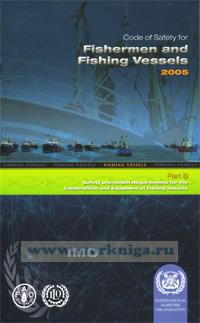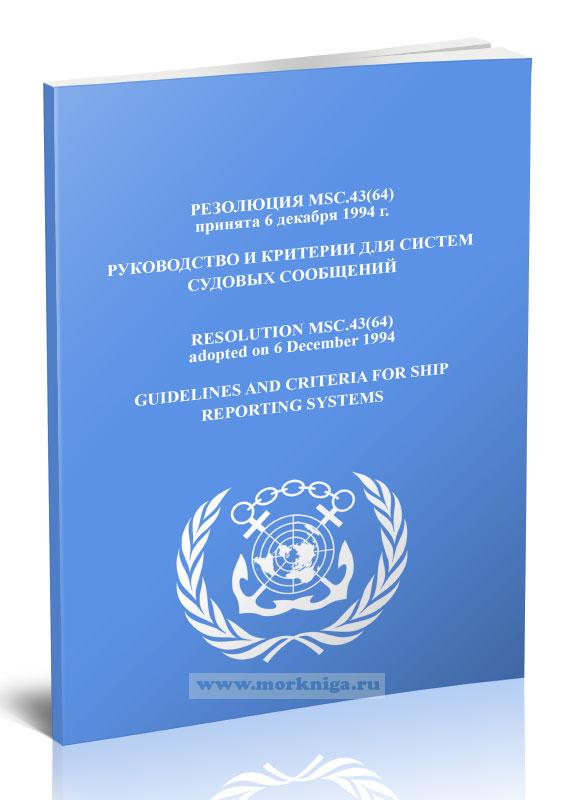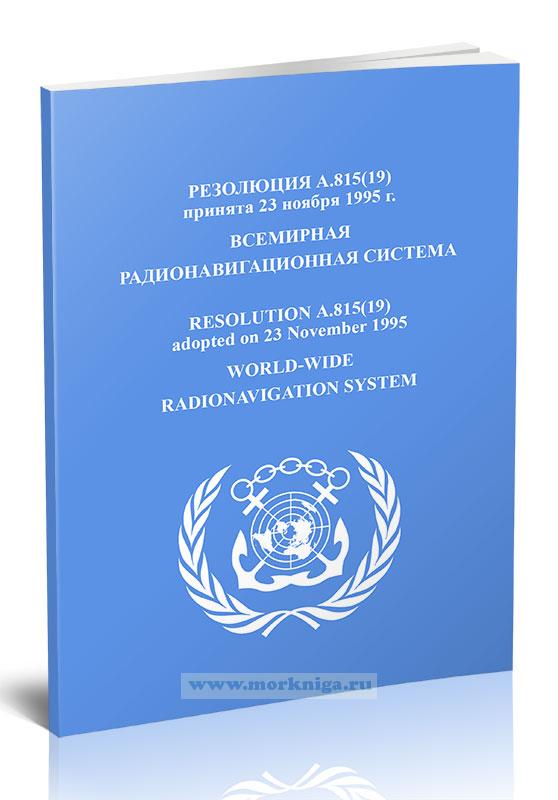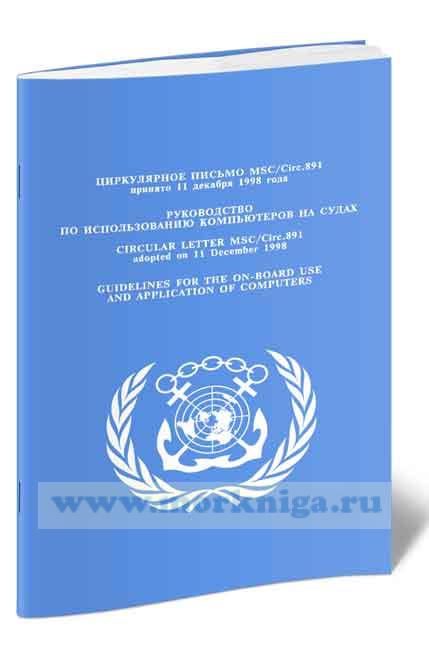Code of Safety for Fishermen and Fishing Vesselsm, Part B (2005). Safety and Health Requirements for the Construction and Equipment of Fishing Vessels
Содержание:
Введение
1 The Code of Safety for Fishermen and Fishing Vessels originated
from a resolution adopted by the International Labour Organization (ILO)
in 1962. Subsequent to that resolution, the Food and Agriculture
Organization (FAO), ILO and the International Maritime Organization
(IMO) entered into an agreement to co-operate, within their respective
fields of experience, to elaborate the Code. The agreement acknowledged
that the respective areas of competence are:
o FAO - fisheries in general;
o ILO - labour in the fishing industry; and
o IMO - safety of life, vessels and equipment at sea. The Code was elaborated in two parts:
.1 part A to be addressed to skippers and crews, containing operational and occupational requirements; and
.2 part В to be addressed to shipbuilders and owners, containing requirements for the construction and equipment for fishing vessels.
2 Part A of the Code was adopted by the first session of the Joint FAO/ ILO/IMO Meeting of Consultants on Safety on Board Fishing Vessels which was held at ILO Headquarters in Geneva in September 1968-
3 Later amendments to part A were approved by the Marl lime Safety Committee (MSC) of IMO, at its thirtieth session in the spring of 1973. At the same session, the Committee approved the final text of part В which was endorsed by the FAO Council at its 64th session (autumn 1974) and also endorsed by the Governing Body of the ILO at its 195th session (February 1975).
4 In 1977, an International Conference on the Safely of Fishing Vessels adopted the Torremolinos International Convention for the Safety of Fishing Vessels, 1977 which, for a number of reasons, did not enter Into force. Consequently, a further International Conference was convened, also in Torremolinos, Spain, that adopted the Torremolinos Protocol of 1993 relating to the Torremolinos International Convention for the Safety of Fishing Vessels, 1977, hereinafter referred to as the Protocol.
5 The Conference also adopted, inter alia, resolution 4 in which it Is noted that the Protocol does not contain specific requirements for certain safety equipment for fishing vessels of less than 45 m m length, such as life-saving appliances. Consequently, it urged all States, in view of the inherent risks involved in the operation of fishing vessels, to consider the requirements for safety equipment when deciding, in accordance with article 3(4) of the Protocol, which regulations they should apply, wholly or in part, to fishing vessels of 24 m in length and over but less than the applicable length criteria of the chapter in question.
6 It was also noted that initiatives had been taken by certain States to develop uniform regional standards as called for in article 3(5) of the Protocol to ensure that the safety of fishing vessels covered by article 3(4) thereof is maintained at an acceptable level by determining which regulations, contained in the annex to the Protocol should apply, wholly or in part, to such vessels.
7 In its review of regional standards so developed, the MSC of IMO noted that they had been examined by the Sub-Committee on Stability and Load Lines and on Fishing Vessels Safety (SLF) with a view to the desirability of developing a template for other countries or regions (see documents MSC 68/ INF. 10 and MSC 70/INF.24). It was also noted that in the examination process, the provisions of these regional standards had provided valuable information in relation to the revision of part В of the Code.
8 The MSC accepted that for certain sizes of vessels, the minimum standards contained in the Protocol should be applied and considered that it would be appropriate to refer to such provisions of the Protocol, where relevant in the revised text of part В of the Code. It was also accepted by the Committee that any such references must stress the voluntary nature of the Code and substitute the mandatory terms "shall" and "will" with the word "should".
9 The MSC acknowledged that there had been significant developments in relation to the management of fisheries that contained principles in support of the safety of fishermen and Ashing vessels. It noted in particular:
.1 the agreement for the Interpretation of the Provisions of the United Nations Convention on the Law of the Sea of 10 December 1982 Relating to the Conservation and Management of Straddling Fish Stocks and Highly Migratory Fish Stocks of 1995; and
.2 the Code of Conduct for Responsible Fisheries adopted by the Conference of FAO in 1995.
10 The MSC recognized that the safety at sea aspects contained within
these instruments could be relevant in relation to the revision of part B, in
particular:
.1 the arrangements for the monitoring, control and surveillance of fishing vessels including recommendations for the reporting of the position of a fishing vessel at sea;
.2 the marking of fishing vessels in accordance with uniform and internationally recognized systems such as the FAO Standard Specifications for the Marking and Identification of Fishing Vessels*; and
.3 the integration of fishing vessels into search and rescue systems.
11 In entrusting the revision of the Code to the SLF Sub Committee, the MSC recommended that the recent developments in fishing vessel design and fishing operations should be taken into consideration. The MSC also entrusted the SLF Sub-Committee to revise the Voluntary Guidelines for the Design, Construction and Equipment of Small Fishing Vessels, that had been approved by MSC in 1979, which addresses vessels of 12 m in length and over but less than 24 m in length. In this regard. IMO was requested to invite FAO and ILO to participate in the revision, Both Organizations responded positively to the subsequent invitation.
12 The SLF Sub-Committee established a correspondence group to facilitate the revision of the Code and the Voluntary Guidelines and, following clearance by the relevant sub-committees of the IMO. the revised text was submitted to the MSC at its seventy-ninth session (1 to 10 December 2004) at which it was approved. At the twenty-sixth session of the Committee on Fisheries in March 2005, FAO welcomed the revised Code and Voluntary Guidelines and recommended the early publication by IMO of these documents. The Governing Body of ILO approved the revised texts at its 293rd session in June 2005.
13 Concerning the procedures for future amendments to the Code and the Voluntary Guidelines, the MSC considered that any amendments should be effected as expeditiously as possible. It was agreed that non-controversial amendments should be approved by correspondence but joint meetings of experts might be necessary for other amendments for which no ready agreement by correspondence could be reached.
14 Recognizing that the majority of items covered by the Code and the Voluntary Guidelines are within the scope of IMO and noting the different working procedures within the three Organizations and also that the SLF Sub-Committee holds regular meetings, it was agreed that:
.1 IMO should act as a focal point for co-ordinating proposed amendments to the Code and in particular the IMO Secretariat should undertake to receive any proposed amendments, to distribute them to the Organizations and to collate their respective comments;
.2 any future joint FAO/ILO/IMO meeting should be held, whenever possible, in conjunction with a meeting of the SLF Sub-Committee; and
.3 any proposed amendments should always be subject to the final approval of the appropriate bodies of the three Organizations.

 Резолюция MSC.43(64) Руководство и критерии для систем судовых сообщений
Резолюция MSC.43(64) Руководство и критерии для систем судовых сообщений  Резолюция А.815(19) Всемирная радионавигационная система
Резолюция А.815(19) Всемирная радионавигационная система  Циркулярное письмо MSC.Circ.891. Руководство по использованию компьютеров на судах
Циркулярное письмо MSC.Circ.891. Руководство по использованию компьютеров на судах